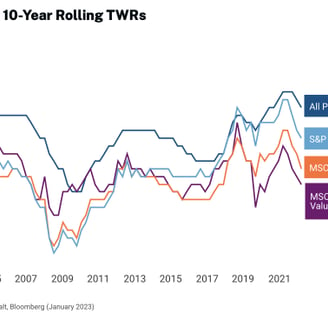(source : Hamilton Lane)
Graphs like the one above are galore if you browse the net and seek for a comparative analysis of private vs public equity. Some say that PE outperforms, others say that it is public equities. Still others say that PE used to outperform, but will not any more in the future. All of them are right, but all are also wrong because they have a bias. First, Private Equity is private. So returns are not publicly available, or only partially. Top-decile funds tend to keep their performance for their investors, shying away from public spotlight... On the other hand, public indices are also biased by stock market fashions (like in 7 companies make the performance of the S&P 500).
The purpose of this post is not to conclude. Or rather, to try to get back to the fundamentals. Both PE and Public Equity invest in the same thing : the equity of a company, to own a portion of it, and to hope that the future economic performance of the company will allow to create value and to sell with a profit.
So should we oppose both types of assets ? For sure there are differences between the two types of investments, but the overall objective is the same : invest in a company, see it thrive, and then sell.
An investor in a private company has a number of constraints, but also advantages :
- He has been chosen by other stakeholders, based on the value he brings to the company he invests in. Indeed, co-shareholders and management teams have a number of criteria that bring them to favor one investor rather than another. Besides the valuation, he will be judged on his ability to help the company in its development plans. This happens through network, door-opening, and additional capital to fund investments. Such differentiation is all the more important the younger the company is. Most VCs or Growth Funds do not lose on valuation. They lose to some other fund who is judged to be better suited to bring the target to the next step.
- In exchange, a PE investor is much closer to the asset, is aware of everything that happens in the business, and has constant exchanges with its management. This constant (at least weekly) exchange allows to have no bad surprises. Mind you, problems arise, bad things happen, but usually, if the investor does his job well, he is aware quasi-immediately. Hence he can react swiftly and support the management adequately. He is not a burden, he contributes to solve problems.
- On the other side, he is stuck with an investment since there usually is no immediate liquidity. An investment undergoing difficulties is time-consuming, source of stress, and there is no choice other than trying to fix the problem, if you want to sell at one point in time.
Investors in public equity usually have less information on the asset they invest in (insider trading forbids this), have no way to put weight on the company to change strategy or managers other than voting with their feet, i.e. sell their stock. However, they can sell, since usually stock markets provide liquidity.
Our view is to not oppose the two, but to be aware of the differences between both types of investments. Some say, and we tend to agree with that, that the specificities of PE allow to achieve a better performance over the long term. Indeed, a PE investor has better access to information, before deciding to invest and during his holding period, has a grasp on the company and its management and has achieved a total alignment of interest.
We hope that you enjoyed this introduction and will develop these main differences in a series of posts in the near future !
Please share your thoughts and comments on this site, or write to contact@korafin.com


